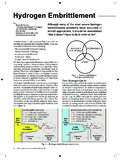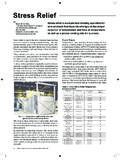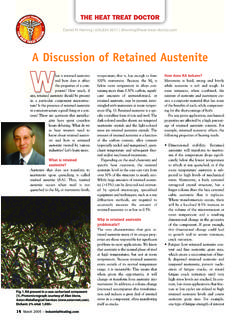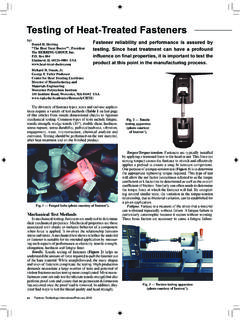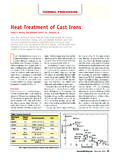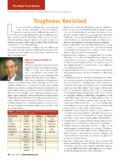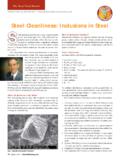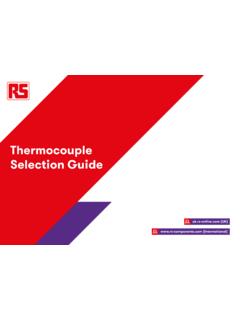Transcription of Grain Size and Its Influence on Materials Properties
1 S metallurgists, we know theimportance of Grain size,and as heat treaters, weneed to be sure we under-stand how Grain size will affect mechani-cal Properties especially when designingour process recipes. Let s learn more. Grain size specificsThe Grain size of carbon andalloy steels is generallyunderstood to mean prioraustenitic Grain size. Onheating steel through itscritical range, transforma-tion to austenite takesplace. The austenite grainsare extremely small when first formed,but grow in size as the time and temper-ature are increased. The Grain size willremain small for steels held at tempera-tures just above the (upper) critical. Athigher temperatures, however, differentsteels shown wide variation in Grain size,depending on chemical composition andsteelmaking (deoxidation and priortreatment) in which elements such as Aland V have been added produce finely-dispersed, not readily soluble and highlyrefractory carbides or oxides, and main-tain a slow rate of Grain growth at 925 C(1700 F) and above.
2 Steels withoutthese additions usually develop a rela-tively large austenitic Grain size at tem-peratures somewhat below this tempera-ture. If you overheat steels with grainrefinement additions, such that the finedispersed phases dissolve or coalesce,then you can end up with a larger grainsize than for alloys where these grainrefinement additions are not , research is underway to findways to increase carburizing temperaturesas high as 1150 C (2100 F) while avoid-ing excessive Grain growth. Microalloyingelements such as Al, Nb and Ti haveshown considerable promise [1]. Grain size effect on propertiesGrain size has a measurable effect onmost mechanical Properties . For exam-ple, at room temperature, hardness, yieldstrength, tensile strength, fatiguestrength and impact strength all increasewith decreasing Grain size.
3 Machinabilityis also affected; rough machining favorscoarse Grain size while finish machiningfavors fine Grain size. The effect of grainsize is greatest on Properties that arerelated to the early stages of deforma-tion. Thus, for example, yield stress ismore dependent on Grain size than ten-sile strength [2, 3].Fine- Grain steels do not harden quiteas deeply and have less tendency tocrack than coarse- Grain steels of similaranalysis. Also, fine- Grain steels havegreater fatigue resistance, and a fine grainsize promotes a somewhat greater tough-ness and shock resistance. Steels madefine grained by addition of aluminumhave machinability inferior to thosemade without aluminum. Also, coldworking frequently alters Grain size bypromoting more rapid coarsening of thegrains in critically stressed areas.
4 Theoriginal Grain size characteristics, howev-er, can usually be restored by stressrelieving. Coarse- Grain steels have bettercreep and stress rupture propertiesbecause diffusion at high temperatures isimpeded by subgrain low-angle bound-aries present in coarse- Grain steels [4].Measuring Grain sizeGrain size can be measured using anoptical microscope on a transverse met-allographic mount (because rolling elon-gates the grains) by counting the numberof grains within a given area, by deter-mining the number of grains that inter-sect a given length of a random line, orby comparison with reference pictures(standards). Grain size can range from 00to ( to mm) accord-ing to ASTM E112-96(2004). For coars-er structures, the number of grains can becounted manually within a certain area,and then calculating the Grain size.
5 Inmeasuring austenitic Grain size, the timeand temperature must be constant toproduce reproducible characteristics of the individualgrains also add to the complication ofmeasurement. First, the three-dimen-sional size of the grains is not constantand the sectioning plane cuts throughthe grains at random. Thus, on any crosssection, a range of sizes is observed, nonelarger than the cross section of the largestgrain sampled. Grain shape also varies,particularly as a function of Grain that Grain size measure-THE HEAT TREAT DOCTORD aniel H. Herring | | rialH Grain Size and Its Influence onMaterials Properties20 August 2005 1 Ferrite Grain structure of a lamination steel;2%nital 2 Austenite grains with annelaing twins in AISIType 316 stainless steel; Kalling s number 2 etch.
6 Table 1 Test methods to determine Grain sizeTest methodDescriptionCommentsFracture methodVisual examination of fracture surfacesWorks well assuming you have both a material that fails in an intergranular mode and a set of comparative blocks. Analysis of the fracture surface via SEM is excellent and indicates actual prior austenite Grain testCarburize at 1700 F (925 C) 8 hr, cool slowly to allow proeutectoid ce-mentite to mark the Grain boundariesCementite covers well, but only in small areas of the sample. Outlining (ferrite) methodSlow cooling hypoeutectoid steels outlines austenite Grain boundaries with ferriteFerrite does not cover that well and grows methodPreferential oxidation of austenite Grain boundariesSurface limitedQuench methodQuenching produces partially hardened zone wherein the former austenite grains consist of martens-ite surrounded by a small amount of fi ne limitedSpecial etching techniquesDevelops contrast between martens-ite grains of the same size as the austenite grains prior to shows actual prior austenite Grain size, but is diffi cult to control.
7 Only certain grades/carbon levels work, and there is an art to the etching and groovingPreferentially evaporates austenite Grain boundaries ASTM Grain size in terms of the number of grainsASTM Grain size numberNumber of (mm2) at 100x1Up to 1-1/221-1/2 - 333 - 646 - 12512 - 24624 - 48748 - 96896 and overment is also complicated by the differenttypes of grains that can be present in met-als, although their fundamental shapes arethe same. In body-centered cubic (BCC)metals, such as Fe, Mo, and Cr, we havegrains produced in ferritic structures (Fig. 1);in face-centered cubic (FCC) metals, suchas Al, Ni, Cu, and certain stainless steels,we have grains produced in austeniticstructures (Fig. 2). The grains have thesame shapes and are measured in the sameway, but we must be careful in describingwhat kind of grains are being example, in the FCC metals, theremay be so-called twin boundaries within thegrains, produced by annealing or deforma-tion.
8 Twins are ignored if trying to define thegrain size. However, if trying to establish arelationship between microstructure andproperties (strength, for example), twinboundaries must be taken into considerationas they Influence dislocation movement, justas Grain boundaries do. There also arepearlite packet boundaries in , we must recognize the intent ofthe work being number of standard measurementmethods can be used (Table 1), and it isimportant to recognize that all of them arevery subjective. Software has been devel-oped to help make Grain measurement andcounting easier (although it still is necessaryto understand what you are trying to meas-ure to ensure representative results).Automated systems usually use simplemenus and easy wizard guides; use vertical,horizontal, concentric circle or diagonalline intercept methods; perform calcula-tions according to ASTM standards; calcu-late average Grain size from multiple images;and manually add or remove standardsASTM International ( ) has anumber of standards for determining thegrain size of various Materials .
9 For steels,E112-96(2004): Standard Test Methods forDetermining Average Grain Size standards have also been introducedto deal with particular situations including: E930-99: Standard Test Methods forEstimating the Largest Grain Observed ina Metallographic Section, (ALA GrainSize) to handle the measurement of occa-sional very large grains present in an oth-erwise uniform, fine Grain size dispersion E1181-02: Standard Test Methods forCharacterizing Duplex Grain Sizes or forrating the Grain size when the size distri-bution is not normal; for example, bi-modal or duplex steels E1382-97(2004): Standard Test Methodsfor Determining Average Grain SizeUsing Semiautomatic and AutomaticImage lower ASTM Grain size number meansthe greater the number of grains, as shownin the following also is an equation expressing therelationship between Grain size and yieldstrength.
10 Bending fatigue also follows a sim-ilar relationship. IHReferences1. Hippenstiel, F., et. al., Innovative CaseHardening Steels as Taylored MaterialSolution for High Temperature Carburizingof Gear Components (In German), HTM 57(Harterei-Technische Mitteilungen), p 290-298, 4/20022. Dieter Jr., ,Mechanical Metallurgy,McGraw-Hill, 19613. Thelning, ,Steel and Its Heat Treatment,Bofors Handbook, Butterworths, 19674. Modern Steels and Their Properties ,Handbook 268, Bethlehem Steel Co., 19495. Grossman, and Bain, ,Principles ofHeat Treatment, 5th Ed., ASM International, , , Timken Co., private correspondence22 August 2005 rialH Additional related information may befound by searching for these (and other)keywords/terms via BNP Media LINX : Grain size, grainrefinement, austenitic Grain size, fine Grain ,coarse Grain , subgrain, ASTM Grain size num-ber, Grain size measurement.
